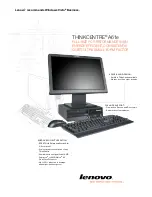
8
Engine type
Each of the engines can be set to any one of four engine types.
The controls available in the engine are dependent on the current engine type setting. Note that some controls are
common between several engine types, and their settings persist when switching between engine types.
1. Arpeggiator (section 8:10)
This engine type allows easy use of Animator as an arpeggiator. Pattern Graph values are applied to the arpeggiator
pattern, allowing much more interesting sequences than are possible with conventional arpeggiators.
. Note Sequencer (section 8:11)
The Note Sequencer engine type is used to generate note events. It operates in a similar way to classic ‘groovebox’ step-
sequencers such as the TB-303.
. Modulation Sequencer (section 8:1)
This engine type is used for parameter modulation sequencing. Note input is fed through to the destination synth,
while the engine must be routed to parameter modulation via the destination synth’s TransMod slots, or to any other
modulateable parameter within Fusor.
4. Advanced (section 8:1)
The Advanced engine type is a complex combination of the other types, with many extra functions and possibilities.
There are 12 pattern memories and the base values of Graphs can be modulated via the FuseMod system.
Clocking
This area of Animator controls each pattern’s length and timing settings. Each
pattern in each of the 4 engines can be clocked independently with different
settings. This is great for polyrhythmic music and avoiding overly repetitive
sequencing. Try combining modulation sequences and note sequences of
different lengths and/or speeds for interesting polyrhythmic effects.
Steps
This control sets the length of the pattern in steps, from 1 to 128.
The default setting is 16 steps.
Step Duration
This control adjusts the length of each step, in musical note length values.
The default setting is 1/16th notes.
Multiplier
The 2 drop-down menus for this function allow you to multiply the clock rate by a
fraction or by a multiple.
A setting of 1/2 means that the clock rate is halved (the effective step duration is
doubled), while a setting of 2/1 results in doubling the clock rate (halving the effective
step duration).
The default setting is 1/1, meaning that the effective step duration is unmodified.
Swing
Each pattern can have a different amount of swing applied (for syncopation effects), using any available
swing template.
Use the swing preset picker to choose a swing template, and adjust the
Swing
control to specify the amount
of swing applied.
Important note about clocking and triggering
For most triggering modes, Fusor’s clock must be running for Animator to function.
Therefore, the Fusor transport should be started when using these modes.
The ‘Advance’, ‘NoteScale’, ‘NoteWrap’ and ‘Ext. Mod’ modes (available when using the Advanced engine
type) do not require that the clock be started, although it must be running for full functionality. See section
8:13 for more details.
Driving devices with Animator
When using an engine for sequenced notes or arpeggiator patterns, you can route its output to any single synth channel,
or to the Key Map page if you want to use it for more than 1 synth at a time.
If you are using Animator as a modulation sequencer (to sequence parameter values), you must route this modulation
using the FuseMod system, via the Step1-4 sources.
Содержание DCAM SYNTH SQUAD
Страница 1: ......
Страница 2: ......
Страница 26: ...26 Shaper Filter Amp sections...
Страница 109: ......
Страница 110: ......
















































